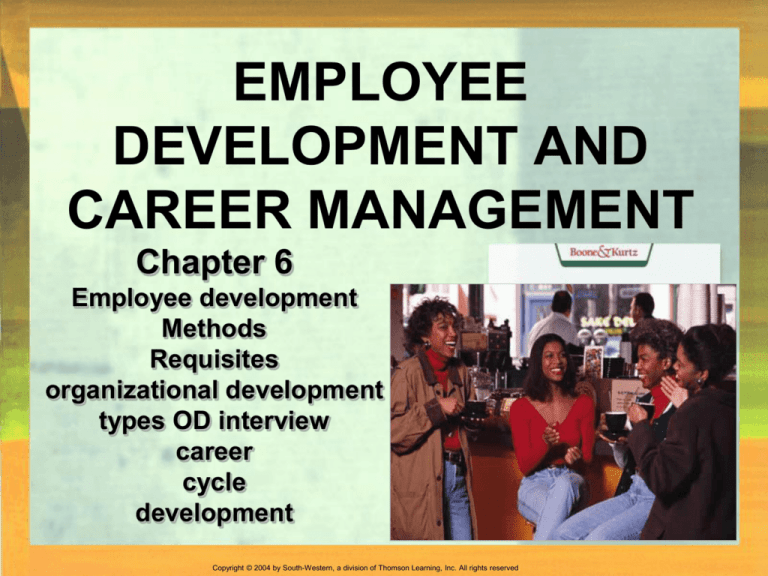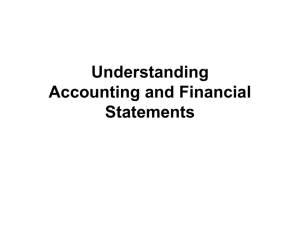
EMPLOYEE
DEVELOPMENT AND
CAREER MANAGEMENT
Chapter 6
Employee development
Methods
Requisites
organizational development
types OD interview
career
cycle
development
Copyright © 2004 by South-Western, a division of Thomson Learning, Inc. All rights reserved.
Employee Development and
Career Management
“An organization will be
in a better position to
achieve its goals, longterm or short-term, if
its employees ate able
to use their talents and
abilities to the fullest
extent possible.”
8-2
Copyright © 2004 by South-Western, a division of Thomson Learning, Inc. All rights reserved.
Employee Development
Employee Development or Human
resource development
Activity focused on increasing the
capabilities of employees for
continuing growth and advancement
in the organization.
8-3
Copyright © 2004 by South-Western, a division of Thomson Learning, Inc. All rights reserved.
Employee Development
Attempt to provide employee
with the ability :
1. To understand cause and
effect relationship
2. To synthesize from
experience
3. Visualize relationship
4. To think logically
8-4
Copyright © 2004 by South-Western, a division of Thomson Learning, Inc. All rights reserved.
Method of Employee Development
Categories:
1. On the job
1)
2)
3)
4)
5)
6)
7)
Job rotation
Asst to position
Mentoring
Special project
Committee assignment
Formal education
Outdoor training
2. Off the job
8-5
Copyright © 2004 by South-Western, a division of Thomson Learning, Inc. All rights reserved.
Requisites for Successful
Employee Development
1. Top management
support
2. Understanding of
development
interrelationships
(Development Efforts rendered
8-6
useless)
Improper appraisal
Improper placement
Improper compensation
Improper selection
Copyright © 2004 by South-Western, a division of Thomson Learning, Inc. All rights reserved.
ORGANIZATIONAL DEVELOPMENT
Definition:
Part of HRM that deals with facilitating
system wide change in the
organization
Long range effort
Solve problems
Collaborative management
Effectiveness of work group
Change agent
Applied science
8-7
Copyright © 2004 by South-Western, a division of Thomson Learning, Inc. All rights reserved.
Components of OD
1. Sensitivity training
2. Process consultation
3. Survey feedback
4. Team building
5. Inter-group
development
8-8
Copyright © 2004 by South-Western, a division of Thomson Learning, Inc. All rights reserved.
Types of OD Interventions
OD Intervention refers to OD proponents
to affect changes
Classification:
1. Technical intervention
2. Administrative
intervention
3. Social intervention
8-9
Copyright © 2004 by South-Western, a division of Thomson Learning, Inc. All rights reserved.
CAREER MANAGEMENT
Career – refers to the pattern of work-related
experiences that span the course of a person’s life.
Career Development – process designed by the
organization to assist employees in managing their
career.
Career Development System – means used to
implement career development.
system of process and practices designed to link an
individual employee’s career goals.
Career Planning - set career goals and how to
achieve.
Career Management – shaping the path to career
progression.
8-10
Copyright © 2004 by South-Western, a division of Thomson Learning, Inc. All rights reserved.
Components of Career
Planning Systems
1. Self-assessment
2. Reality check
3. Goal setting
4. Action planning
8-11
Copyright © 2004 by South-Western, a division of Thomson Learning, Inc. All rights reserved.
CAREER CYCLE
Characterized by position, stages,
and transitions experienced by
individual employees
1. Growth stage
2. Exploration stage
3. Establishment stage
4. Maintenance stage
5. Decline stage
8-12
Copyright © 2004 by South-Western, a division of Thomson Learning, Inc. All rights reserved.
How the make Career Development
more effective?
1. Challenging initial job
assignments.
2. Career counseling
3. Career development
workshop
4. Continuing education and
training
5. Periodic job change
6. Multiple career task
7. Professional associations
8. Supportive environment
8-13
Copyright © 2004 by South-Western, a division of Thomson Learning, Inc. All rights reserved.
PRESSURES USED BY THE
EMPLOYER
1. Lockouts
To force union stop harassing the employer
Accept conditions set by management
Prevent work slowdowns
Prevent damage to property
Prevent violence in the premises
2. Strikebreakers
People are hired to replace strikers
3. Employer’s association
8-14
Copyright © 2004 by South-Western, a division of Thomson Learning, Inc. All rights reserved.
Thank You
Give instruction to a wise man,
and he will be still wiser;
teach a righteous man, and he
will increase in learning.
8-15
Copyright © 2004 by South-Western, a division of Thomson Learning, Inc. All rights reserved.







